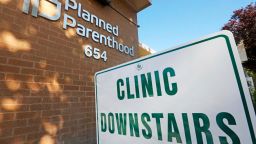The central paradox of the abortion debate is that the red states racing to outlaw or severely limit the procedure may be the places least prepared to deal with the practical consequences of the new restrictions. And that, experts project, could mean significantly more infant and maternal deaths and childhood poverty in states that, as a group, already rank at the bottom on those critical outcomes for kids and families.
New research shows that the states banning abortion could see up to hundreds of thousands of new births each year, most of them unplanned, and concentrated among lower-income families already facing the greatest financial and health care challenges. Social scientists have consistently found that those unplanned pregnancies tend to produce worse outcomes for kids and mothers – and, with abortion prohibited or severely limited, they now will be rising precisely in states, including most of the South, that traditionally have invested the least in health, education and other social supports for families.
“It is as if somebody came down with a magic marker and circled the states least equipped to deal with an abortion ban and with the largest percentage of their population falling into the most elevated risk categories,” says Sara Rosenbaum, a professor of health law and policy at George Washington University, who helped organize an amicus brief in the abortion case from over 500 social scientists.
“So, you are setting up a prescription for phenomenal effects in terms of maternal mortality, infant mortality, infant low birthweight, all of the risks that follow from these kinds of [unplanned or unwanted] pregnancies.”
Especially frustrating for social scientists is that while the majority opinion from Justice Samuel Alito overturning Roe v. Wade reached so deeply into history that it cited “Henry de Bracton’s 13th-century treatise” on abortion, the ruling said nothing about the real-world effects today of allowing states to ban or severely restrict the practice. “This is what I can describe only as the horror of this all, which is that the court utterly disregarded, as did Mississippi, the practical health implications of what it was doing here,” Rosenbaum says.
Among the most ominous outcomes is that social scientists project the number of women who die from complications in childbirth could increase by double digits in the states banning abortion. In a new paper, Amanda Jean Stevenson, an assistant professor of sociology at the University of Colorado at Boulder, and two co-authors projected that maternal mortality would increase by 14% in the 26 states expected eventually to ban or severely restrict abortion.
Stevenson, in an interview, said that was likely a conservative estimate because it is based on the states’ overall rates of maternal mortality and the additional births after abortion is banned would be concentrated among lower-income women who traditionally face the most health risks during pregnancy. Another factor that could increase maternal mortality rates, Stevenson says, is that care may be delayed as doctors seek legal guidance before treating miscarriages or ectopic pregnancies for fear of violating the new abortion limits. “They will have to wait longer for people to be sicker before they can justify life-saving care,” she predicts, and the same legal fears may cause pregnant women to delay seeking care as well.
Linda Goler Blount, president and CEO of the Black Women’s Health Imperative, said in an interview their research forecasts that the number of Black women who die from childbirth could rise by fully 33% with Roe overturned. Poverty rates could increase as much as 20%, the group projects. “Lives will be lost, just from the death in and around pregnancy, but also those deaths of despair when you get another generation of people into poverty,” Goler Blount says.
Like many anti-abortion advocates, Patrick Brown, a fellow at the Ethics and Public Policy Center, a conservative think tank, pushes back by arguing that whatever the consequences, “is it better for the baby not to be born at all?” as he put it in an interview. But he acknowledges “the social outcomes…wouldn’t be great” if the states banning abortion don’t provide more help for women and children. “Now that Roe is gone and states have the opportunity to protect unborn life,” Brown says, “it really increases the moral obligation for Republican-dominated states to make sure that women … have the resources they need to be able to carry that child to term and to make sure that mom and baby are healthy.”
No one can predict precisely how many additional births the states banning abortion will face. But the best evidence is that the number will be substantial.
In their paper, Stevenson and her colleagues reported that in 2020 just over 322,000 abortions were performed in the 26 states expected to eventually ban or restrict the procedure. The authors calculate that, as a general rule, about eight additional children are born for every 10 abortions that are denied. (The relationship is less than one-to-one, Stevenson says, because some pregnancies will end in miscarriages and also because some women who undergo abortions might soon become pregnant again.)
The actual total of additional births following an abortion ban might not be quite that high, Stevenson noted in an interview, because some of the restrictive states will still permit some abortions (Florida, for instance, has set a 15-week ban), and also because some women will travel out of state to obtain one. But even with those caveats, Stevenson says the states restricting abortion remain likely to see a surge in new births, possibly in the range of hundreds of thousands.
“If abortion is banned, as we expect it to be, a substantial fraction of these people will remain pregnant,” she told me. If the abortion bans cause even about 180,000 or so new births a year, that would represent an increase of roughly 10% in the total number of births (about 1.8 million) these states currently experience.
What’s more, these births would be concentrated among the populations most at risk for adverse outcomes, both for mothers and children. Many experts agree that abortion bans will affect women of all income classes and in all states, in part as providers in blue states are strained to meet increased demand from the places where it is banned. But as Stevenson notes, roughly three-fourths of the women receiving abortions nationwide live in families earning 200% or less the federal poverty level, about $55,000 for a family of four. In its brief to the Supreme Court, the large group of social scientists noted that women in those income brackets experience “significantly higher” rates of unplanned pregnancies than more affluent women, who have greater access to health care.
“Women who carry unintended, and especially unwanted, pregnancies to term are more likely to experience a wide range of adverse health outcomes including depression, poor birth outcomes, interpersonal violence, and psychological distress,” the social scientists wrote. “Compared to those able to obtain abortions, women who are denied abortions are also subsequently more likely to live in poverty, more likely to lack financial supports critical to better health outcomes, such as housing and nutrition, and more likely to raise their children alone.”
In addition, the brief noted, “unintended, and especially unwanted, pregnancy is strongly associated with preterm birth and low birthweight, linked outcomes that together are leading causes of child health problems and infant mortality. … Preterm birth and low birthweight can cause lifelong health and developmental challenges.”
To the extent the abortion bans result in more preterm and low birthweight births, that “means those babies are going to need more support than a typical child,” says Cynthia Osborne, professor of early childhood education and executive director of the Prenatal-to-3 Policy Impact Center at Vanderbilt University.
Those needs will extend, she notes, far beyond infancy: “They are going to need more health care, because children born low birthweight or premature are much more likely to need early intervention services, to be in the neo-natal unit,” she says. “They are going to need more special ed services because those children grow up to need higher levels of special ed services when they reach school age. These are going to be families who are going to be struggling to figure out how to provide for this child they may love very much now that it’s here but were not ready emotionally or financially to support.”
But these additional births would occur in states that are, by all measures, the least prepared to handle such challenges. As I’ve written, the states moving to ban abortion consistently rank near the bottom on virtually every measure of health and economic well-being for mothers and children.
To take one example, Rosenbaum notes that “the first thing any expert in obstetrics and gynecology will tell you is the single most important determinant of how a woman fares in pregnancy is her health going into pregnancy.” But data from the Center for Health and Social Policy at the University of Texas LBJ School of Public Affairs show that most of the states moving to ban abortion rank near the bottom in the percentage of low-income women covered by health insurance. Texas ranks dead last on that measure among the 50 states, followed in order by Oklahoma, Georgia, Florida, Mississippi and Missouri – all states that are banning or retrenching access to abortion. In all, the states that have already moved to restrict abortion in the days since the Supreme Court decision hold 12 of the 16 lowest places on that list.
The story is the same on other critical measures of outcomes for children and parents. The restrictive states include 12 of the 14 that already experience the highest rates of infant mortality, according to the social scientist brief. It includes 10 that rank in the bottom 14 for low birthweight births, and 14 that rank in the bottom 16 for the largest share of children living in poverty, the brief reported.
Anti-abortion states with very low ratings on all or nearly all of those measures include Alabama, Arkansas, Georgia, Florida, Missouri, Oklahoma, Louisiana, Mississippi, South Carolina, Tennessee and West Virginia. Texas, Kentucky and Ohio rank poorly on some, but closer to the middle of the nation on others.
The Annie E. Casey Foundation, in its annual Kids Count reports, pulls together these and other measures to produce an overall ranking of children’s status in the states. The states already moving to limit abortion dominate the lowest rankings on both health outcomes specifically and on the overall outcomes for kids (including economic and educational measures). The Casey rankings place Mississippi dead last on both health and overall outcomes for kids; Texas 49th on health and 46th on overall outcomes; Louisiana 48th on both; Alabama 47th on both; and South Carolina, West Virginia and Oklahoma in the bottom 10 on both. Except for Alaska, all 13 states that rank lowest on health outcomes for kids are among those that have already moved to restrict abortion.
Across all these measures and rankings, the only states moving to ban abortion that generally receive better ratings are relatively smaller, preponderantly White heartland states including North and South Dakota, Idaho, Utah, Wyoming and Wisconsin.
But all of the states moving to ban abortion are characterized by stark disparities in health outcomes across racial lines. Those states “are where life, quite frankly, is the worst for Black and brown people,” says Goler Blount, who holds a masters of public health degree. In almost every state moving to ban abortion, the share of babies born with low birthweights is roughly twice as high for Black as White mothers, according to data from the Center for Health and Social Policy. The share of babies born prematurely is about 50% higher for Black than White mothers across the vast majority of the anti-abortion states, the center found. Reliable data on maternal mortality by race is not as widely available at the state level, but nationally the rate for Black women is more than double the rate for White women.
“We already have problems serving our women of color through long standing discrimination, racism and access to resources,” says Osborne, who formerly directed the Texas center. “This is going to compound those already existing problems.”
Since the five GOP-appointed Supreme Court justices overturned Roe, some prominent social conservative groups have insisted they will push red states to increase their investments in mothers and children. “I do think there is an openness to it now that there wasn’t even 10 years ago,” says Brown. He points to Texas’ decision to invest $100 million in an “Alternatives to Abortion” program designed to discourage women from seeking the procedure and the choice by several anti-abortion states to accept funding under the 2021 Covid-19 rescue bill to extend Medicaid coverage for 12 months to low-income women after childbirth.
But such steps, most experts agree, amount to tiny patches over the gaping holes in the safety net across the states restricting abortion. “It’s totally fair to say that red states have tended to make a much more skimpy approach to the safety net than pro-family conservatives like myself would like to have seen,” Brown acknowledges.
To begin, nine of the states moving to ban or limit abortion have not accepted the federal dollars to extend post-partum Medicaid coverage for 12 months, and two more (Texas and Wisconsin) are offering only shorter extensions. More important, 10 of the states moving against abortion, including Texas, Florida and Georgia, have rejected the much larger expansion of Medicaid under the Affordable Care Act to cover all working-poor adults. (Only two states not on track to ban abortion have refused the expansion.) The anti-abortion states that have refused to expand Medicaid instead have set the nation’s most restrictive eligibility levels. In Texas, Medicaid is available only to parents earning 17% of the federal poverty level (or about $4,700 annually). The number is 18% in Alabama, 25% in Mississippi and just over 30% in Georgia and Florida. Partly as a result, in Texas, Florida and Georgia alone, nearly 9.3 million people lack health insurance.
The same pattern holds on other measures. Only a handful of the anti-abortion states have set a minimum wage higher than the federal level of $7.25 and just four of them have established a minimum of at least $10 per hour. Almost all of the anti-abortion states provide much smaller welfare benefits than the national average; most of them do not provide benefits to pregnant women unless they already have another child and several others do so only in the final trimester of pregnancy. None of the anti-abortion states are among the 10 that have established programs of paid family and medical leave for workers.
It’s always possible that with Roe gone, the red states rapidly moving to ban or limit abortion will reverse generations of policies in which they have historically provided the least support to low-income families and the smallest investment in public services such as education and health care. But it may be more likely, as Stevenson says, that adding tens of thousands of new births in places where poverty is prevalent and the social safety net already so threadbare “is a recipe for a lot of suffering…that individuals and families are going to have to bear on their own without support of the state.”









